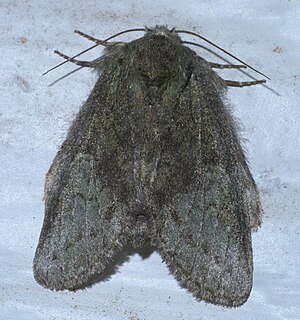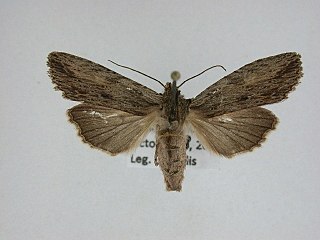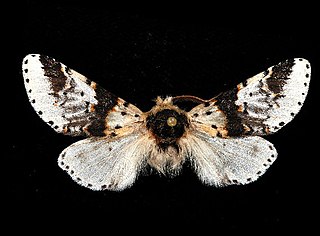Digrammia sexpunctata, the six-spotted digrammia, is a moth in the family Geometridae described by J. Elwyn Bates in 1886. It is found in North America.
Prosoparia perfuscaria, the inornate prosoparia moth, is a moth in the family Erebidae described by Augustus Radcliffe Grote in 1883. It is found in North America.
Tarache arida is a moth in the family Noctuidae described by Smith in 1900. It is found in North America.

Heterocampa umbrata, the white-blotched heterocampa, is a moth in the family Notodontidae described by Francis Walker in 1855. It is found in North America.
Megisto rubricata, the red satyr, is a butterfly in the family Nymphalidae described by William Henry Edwards in 1871. It is found in North America.

Ematurga amitaria, the cranberry spanworm moth, is a moth in the family Geometridae described by Achille Guenée in 1858. It is found in North America.
Phrygionis privignaria is a moth in the family Geometridae described by Achille Guenée in 1858. It is distributed over the Caribbean, North, Central and South America.

Eupsilia vinulenta, the straight-toothed sallow moth, is a moth in the family Noctuidae described by Augustus Radcliffe Grote in 1864. It is found in North America.
Acontia behrii is a moth in the family Noctuidae described by Smith in 1900. It is found in North America.

Lithophane signosa, the signate pinion or sycamore pinion moth, is a species of moth in the family Noctuidae. The species was described by Francis Walker in 1857. It is found in North America.
Parabagrotis cupidissima is a species of moth in the family Noctuidae. It was described by Augustus Radcliffe Grote in 1875 and is found in North America, where it ranges from southern Vancouver Island, along the Pacific Coast states, to southern California. The habitat consists of grasslands and oak woodlands.
Lacinipolia incurva is a species of moth in the family Noctuidae. It was described by John B. Smith in 1888 and is found in North America, where it has been recorded from California, Arizona, New Mexico, Texas, Utah and Colorado.
Leucania commoides, the comma wainscot or two-lined wainscot moth, is a species of cutworm or dart moth in the family Noctuidae. It was described by Achille Guenée in 1852 and is found in North America.
Zale obsita is a species of moth in the family Erebidae. It was described by Achille Guenée in 1852 and is found in North America.

Baileya levitans, the pale baileya, is a species of nolid moth in the family Nolidae. It was described by Smith in 1906 and is found in North America.
Perigonica pectinata is a species of cutworm or dart moth in the family Noctuidae. It was described by Smith in 1943 and is found in North America.
Coxina cinctipalpis, the black-waved owlet, is a species of moth in the family Erebidae. It was described by Smith in 1899 and is found in North America.

Furcula scolopendrina, the zigzag furcula moth or poplar kitten moth, is a species of prominent moth in the family Notodontidae. It was described by Jean Baptiste Boisduval in 1869 and is found in North America.
Tesagrotis corrodera is a species of cutworm or dart moth in the family Noctuidae. It was described by Smith in 1907 and is found in North America.

Egira curialis is a species of cutworm or dart moth in the family Noctuidae. It is found in North America.






